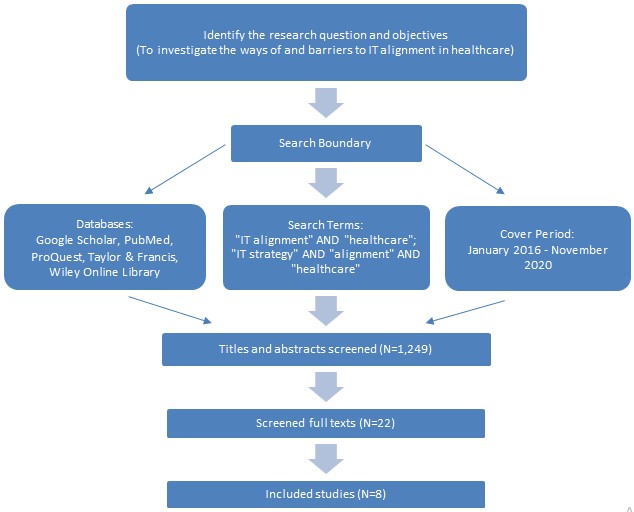For the purpose of this study, a literature review method was chosen to review recent studies on IT strategy alignment in healthcare organizations. The rationale for using this method is to explore how healthcare organizations can align their IT strategies with organizational goals and what managerial and organizational characteristics hinder IT strategy alignment, as reported in the literature. Figure 1 shows how the process of selecting relevant studies was conducted.

First, the cover period for the reviewed literature was limited to studies published within the last five years, with articles published in 2016 being the oldest ones meeting the inclusion criteria. The reason for the exclusion of studies published prior to 2016 is that more recent studies are based on the previous research but include updated concepts, ideas, and findings. Since the area of IT is developing rapidly, it is reasonable to search for the latest studies on IT strategy alignment in healthcare to find up-to-date data and recommendations for practical implementation. Secondly, only English-language studies were included in the review because the author of the current research is not multilingual. Thirdly, the articles were not excluded based on the country they referred to because it was assumed that IT alignment practices were applicable to healthcare management regardless of the national context.
Then, the search was conducted in the following databases and libraries: Google Scholar, PubMed, ProQuest, Taylor & Francis, and Wiley Online Library. The keywords used during this process included IT strategy, alignment, and healthcare. The Boolean operator AND was used to obtain more relevant results. Thus, the search terms were as follows: “IT alignment” AND “healthcare” and “IT strategy” AND “alignment” AND “healthcare.” It was decided that the search terms should appear anywhere in the paper rather than only in the title in order not to miss potentially relevant studies. The search returned 1,060 results in Google Scholar, 2 results in PubMed, 103 results in ProQuest, 42 results in Taylor & Francis, and 42 results in Wiley Online Library. The total number of search results obtained using the search terms mentioned above was 1, 249. The titles and abstracts of the found studies were scanned, and 22 studies were selected. At this stage, studies not related to IT in healthcare were excluded because they were not relevant to the current research.
The next step was to read the full text of the 22 selected studies and determine which of them should be included in the review. It was decided that only peer-reviewed journal articles and books met the inclusion criteria. Therefore, one dissertation, three theses, and five conference proceedings were removed from the selection of eligible studies. The reason for the exclusion of these types of works is that conference proceedings and theses are not necessarily peer-reviewed. Upon a closer look, thirteen other articles and books appeared to cover IT issues not related to IT alignment in healthcare and, therefore, were excluded. The final selection of sources eligible for inclusion contained eight articles, summarized in Table 1.
Table 1. Summary of the included studies and the rationale for inclusion.
Reference List
Farah, S., Bonnet, M. and Damaj, K. (2020) ‘Discrepancies in information technology strategic alignment in healthcare’, International Journal of Business Information Systems, 34(2), pp. 273-292.
Langdale, R. and Glonek, A. (2016) ‘Developing an oncology IT strategy’, Oncology Issues, 31(2), pp. 46-51.
Nair, A. and Dreyfus, D. (2018) ‘Technology alignment in the presence of regulatory changes: the case of meaningful use of information technology in healthcare’, International Journal of Medical Informatics, 110, pp. 42-51.
Price, C., Green, W. and Suhomlinova, O. (2019) ‘Twenty-five years of national health IT: exploring strategy, structure, and systems in the English NHS’, Journal of the American Medical Informatics Association, 26(3), pp. 188-197.
Rusinko, C. (2020) ‘IT responses to Covid-19: rapid innovation and strategic resilience in healthcare’, Information Systems Management, 37(4), pp. 332-338.
Sha, X., Chen, J. E. and Teoh, S. Y. (2020) ‘The dynamics of IT-business strategic alignment: evidence from healthcare information systems implementation’, Information Technology & People, 33(5), pp. 1465-1488.
Snedaker, S. T. (2017) Leading healthcare IT: managing to succeed. Boca Raton: CRC Press.
Wang, Y., et al. (2019) ‘Leveraging big data analytics to improve quality of care in healthcare organizations: a configurational perspective’, British Journal of Management, 30(2), pp. 362-388.